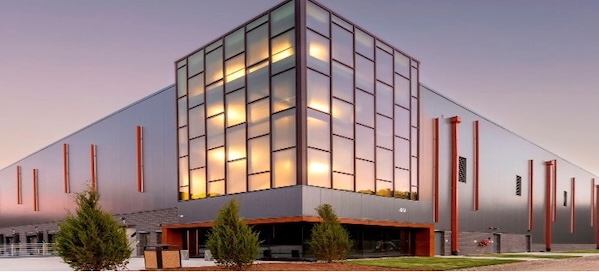this is the path to carbon neutrality
July 4, 2025
Source: drugdu
 98
98
 Is it possible to achieve carbon - dioxide - free operation of pharmaceutical warehouses? The answer is yes. United Therapeutics, a biopharmaceutical company, has built a Good Manufacturing Practice (GMP) - compliant warehouse in North Carolina, southern United States, which is worthy of being called a milestone project. Next, let's take a closer look at the details.
Is it possible to achieve carbon - dioxide - free operation of pharmaceutical warehouses? The answer is yes. United Therapeutics, a biopharmaceutical company, has built a Good Manufacturing Practice (GMP) - compliant warehouse in North Carolina, southern United States, which is worthy of being called a milestone project. Next, let's take a closer look at the details.
Generally, GMP - compliant pharmaceutical warehouses are not energy - efficient buildings. The temperature - control system needs to run continuously, the air humidity needs to be kept stable, and the whole system also needs to go through strict verification. The power consumption of the air - conditioning system is huge, and when a cryogenic area needs to be set up for sensitive active ingredients, the energy consumption is doubled. All in all, these conditions are not ideal for designing a net - zero energy - consumption building.
Nevertheless, it is indeed feasible. The "Project Lightyear" of United Therapeutics has proved the possibility of completely achieving carbon - dioxide - free operation. A GMP warehouse complex has been built in the Research Triangle Park in North Carolina. According to the company, the warehouse is one of the five net - zero buildings and was officially put into use in 2023.
Part 1 The Company's New Flagship Logistics Center is Ready to Set Sail
This distribution center is of great strategic significance, mainly responsible for distributing the drug - device combination Tyvaso DPI. The product was approved by the US Food and Drug Administration (FDA) in 2022 and became the first dry - powder inhaler for the treatment of pulmonary arterial hypertension (PAH). For United Therapeutics, Tyvaso is a key revenue growth point (revenue reached $415.9 million in the fourth quarter of 2024), and the launch of this dry - powder inhaler in 2024 brought an additional revenue of $62.7 million to the company.
Therefore, the investment in this advanced facility, which covers an area of 55,000 square meters and has normal - temperature and cold - storage areas, is expected to be recovered soon. The building with a striking “glass curtain wall” is not only eye - catching in appearance, but also the design team has put a lot of effort into technology, committed to achieving the net - zero energy consumption goal:
• A geothermal system consists of 40 vertical boreholes, each with a diameter of 6 inches (about 15 cm) and a depth of 500 feet (about 152 m). The system uses the temperature of the earth's core to regulate the building system and environmental conditions, and its design allows for the expansion of additional capacity when the demand increases.
• A micro - grid with battery backup uses Tesla Megapack batteries, providing a battery energy storage capacity of 6.2 MWh, which can provide power for the building for more than two days without relying on fossil fuels.
• The photovoltaic system installed on the roof is composed of 1,200 photovoltaic panels, with a peak power of 560 kW and an expected annual power generation of 767 MWh. In addition, the system has signed a net - metering settlement agreement with the local power company Duke Energy.
The photovoltaic system is connected to the project's micro - grid. When the building's power system is disconnected from the power supply network, it can charge the Tesla Megapack batteries, ensuring that the facility can operate for a longer time. This eliminates the need for a backup generator.
The project has also invested in smart building technologies, including installing lighting sensors in key positions, using Energy Star - certified office equipment, and adopting rechargeable regenerative braking forklifts.
Part 2 Maintaining the GMP Environment Even in the Event of a Power Outage
All these systems enable the facility to use renewable energy, send the excess power back to the grid, and maintain a stable current good manufacturing practice (cGMP) environment for normal - temperature and cold - storage areas. The key among them is the micro - grid technology and the battery backup system, which can take over the power supply in case of a power outage or emergency, enabling the facility to operate independently of the public power grid. Through the micro - grid, the facility can work in the “island operation” mode, using the battery backup system to support key loads. Since there is no need to use fossil fuels, the micro - grid also helps to achieve the carbon - neutral goal of the facility.
The facility has been in operation since October 2023, has obtained the LEED Gold certification, and is currently actively applying for the Energy Star certification.
https://pharm.jgvogel.cn/c1525112.shtml
By editorRead more on
- Multiple batches of quadrivalent influenza virus split vaccine have been sub-packaged and submitted for lot release approval; expected to be released to the market soon after approval December 12, 2025
- Ab&B Bio-Tech CO., LTD. JS Lyophilized Human Rabies Vaccine Initiates Phase III Clinical Trials December 12, 2025
- The ‘Sweetest’ HPV Vaccine Market is Gone | Haibin Interview December 12, 2025
- InnoCare Pharma announced that its first independently developed next-generation TRK inhibitor, zoletrazinib, has been approved for marketing in China December 12, 2025
- Is PD-1/VEGF dual antibody + ADC becoming the standard configuration? December 12, 2025
your submission has already been received.
OK
Subscribe
Please enter a valid Email address!
Submit
The most relevant industry news & insight will be sent to you every two weeks.



